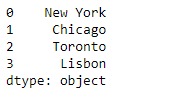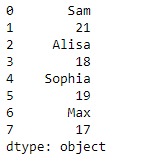Python是进行数据分析的一种出色语言,主要是因为以数据为中心的python软件包具有奇妙的生态系统。 Pandas是其中的一种,使导入和分析数据更加容易。
Pandas Series.at属性使我们能够访问行/列标签对的单个值。该属性类似于loc,因为两者都提供了基于标签的查找。
用法:Series.at
参数:没有
返回:单值
范例1:采用Series.at属性以访问给定Series对象中任何特定位置的单个值。
# importing pandas as pd
import pandas as pd
# Creating the Series
sr = pd.Series(['New York', 'Chicago', 'Toronto', 'Lisbon'])
# Print the series
print(sr)输出:

现在我们将使用Series.at属性以返回存在于Series对象中给定索引处的元素。
# return the element at the first position
sr.at[1]输出:

正如我们在输出中看到的,Series.at属性已返回“芝加哥”,因为该值位于给定Series对象中的第一位置。
范例2:采用Series.at属性以访问给定Series对象中任何特定位置的单个值。
# importing pandas as pd
import pandas as pd
# Creating the Series
sr = pd.Series(['Sam', 21, 'Alisa', 18, 'Sophia', 19, 'Max', 17])
# Print the series
print(sr)输出:

现在我们将使用Series.at属性以返回存在于Series对象中给定索引处的元素。
# return the element at the first position
sr.at[5]输出:

正如我们在输出中看到的,Series.at属性已返回“ 19”,因为该值位于给定Series对象中的第5个位置。
相关用法
- Python pandas.map()用法及代码示例
- Python Pandas Series.str.len()用法及代码示例
- Python Pandas.factorize()用法及代码示例
- Python Pandas TimedeltaIndex.name用法及代码示例
- Python Pandas dataframe.ne()用法及代码示例
- Python Pandas Series.between()用法及代码示例
- Python Pandas DataFrame.where()用法及代码示例
- Python Pandas Series.add()用法及代码示例
- Python Pandas.pivot_table()用法及代码示例
- Python Pandas Series.mod()用法及代码示例
- Python Pandas Dataframe.at[ ]用法及代码示例
- Python Pandas Dataframe.iat[ ]用法及代码示例
- Python Pandas.pivot()用法及代码示例
- Python Pandas dataframe.mul()用法及代码示例
- Python Pandas.melt()用法及代码示例
注:本文由纯净天空筛选整理自Shubham__Ranjan大神的英文原创作品 Python | Pandas Series.at。非经特殊声明,原始代码版权归原作者所有,本译文未经允许或授权,请勿转载或复制。
